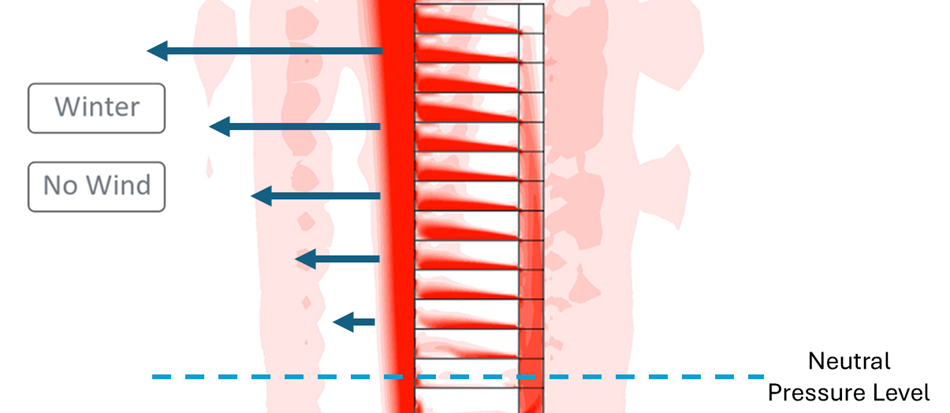
Stack Effect: The Invisible Force of Air Flow in Buildings
One of the most important physical principles that directs air flow inside and around buildings is known as the “stack effect.” Natural air movement primarily originates from the differences in density between the warm and cold air inside a building. Additionally, high-rise structures such as atriums, towers, and large-scale facilities play a critical role. So, what is the stack effect and how can it be controlled?
How the Stack Effect Works
In Winter:
Since indoor air is warmer than the outdoor air, it rises and attempts to exit through openings at the top of the building. This escape creates a negative pressure on the lower floors, causing cold outdoor air to be drawn in.
In Summer:
When the outdoor temperature is higher compared to the indoor temperature, the process reverses. Hot air infiltrates, pushing the cooler air out from the lower levels. This phenomenon is especially pronounced in tall buildings. As the building’s height increases, the pressure difference generated by the temperature difference also grows, resulting in faster air flow.

Negative Effects of the Stack Effect
If the stack effect is not controlled, it can lead to several serious issues:
- Comfort Problems:
Sudden air currents can create drafts around doors and windows. For example, in winter, warm air accumulates on the upper floors while cold air rapidly fills the ground floor. - Pressure Issues at Doors and Windows:
Excessive air pressure makes it difficult to open and close interior doors. - Airflow Problems in Elevator Shafts:
In tall buildings, the stack effect creates unwanted air currents in elevator shafts, negatively affecting elevator performance. - Acoustic Problems:
When zoned areas are not adequately insulated, sounds known as acoustic whistling can occur. - Fire and Smoke Spread:
In the event of a fire, the stack effect can rapidly carry smoke to the upper floors. - Imbalance in Heat Distribution:
Certain areas within the building may become excessively warm or cold, adversely affecting indoor comfort. - Deterioration of Indoor Air Quality:
Uncontrolled air flows can draw in external pollutants, thereby reducing air quality.
During winter, the outdoor air is cold and dense. When a window is opened, this dense cold air moves directly toward the ground, while the slightly warm air inside the building attempts to exit from the top of the window. In the scenario presented, the stack effect in a high-rise building was examined for both summer and winter months. The building has 25 floors and an elevator shaft that opens on each floor.


Additional Details on the Scenario
Leakage Details:
A leakage area of 0.04 m² was identified at the entrance—from the gaps under the door and the elevator door opening into the shaft. In addition, each floor features an open window that allows air to flow in and out of the external environment.
Design Considerations:
Leakage rates for each type of door and window are determined during the design process and factored into the calculations. For instance, loads of 25 Pa or more on elevator doors can trigger operational issues, whereas revolving doors can typically withstand values of up to approximately 130 Pa.
Analysis Conditions:
The analyses assumed an outdoor temperature of 35°C in the summer and 0°C in the winter. The indoor room temperature was initially set at 20°C. Under these conditions, the analyses were carried out over time.

Neutral Pressure Level (NPL) and Its Seasonal Variations
Neutral Pressure Level (NPL) is the pressure balancing level, referring to the height within a building, system, or structure where the internal and external air pressures equalize. In winter, air escapes above this level while entering below it. As observed, in a calm winter environment, the NPL is located on the 13th floor. However, in windy conditions during winter, the NPL shifts one floor upward, settling on the 14th floor. In summer, the air exchange process is reversed. Air expelled from the lower floors is replaced by hot air infiltrating from the upper floors.

In Conclusion
In winter, as air enters through the lower parts, warm air is simultaneously exhausted from the upper floors. The closer one gets to the higher floors, the faster the air entering from the elevator shaft flows. In windy conditions, the high pressure on the windward side increases air intake into the building, causing the balanced pressure level to occur on the higher floors—resulting in an upward shift of the NPL. Conversely, during summer, while air exits from the lower floors, hot air enters from the upper floors. As one moves closer to the lower floors, the velocity of the air entering via the elevator shaft increases.
Measures to Reduce the Impact of the Stack Effect
To mitigate the effects of the stack effect, the following measures can be implemented:
- Ensuring Air Tightness:
Making cracks in the building envelope, doors, and windows airtight can prevent air leakage and reduce the stack effect. - Door and Window Design:
Utilizing revolving doors or air curtains can help control the movement of indoor and outdoor air. - HVAC (Heating, Ventilation, and Air Conditioning) Systems:
Implementing balanced pressurization can effectively manage indoor air flow. - Use of Insulation:
Providing proper thermal insulation minimizes the temperature differences between the interior and exterior, thus reducing the stack effect. - Strategic Placement of Entrances and Exits:
Positioning doors and windows with consideration for wind direction and pressure differences can help minimize the stack effect. - CFD Simulations and Zone Model Approaches:
Especially in large buildings, these techniques can model air flow to:
• Identify critical air leakage points,
• Optimize ventilation and air conditioning systems, and
• Enhance energy efficiency.



